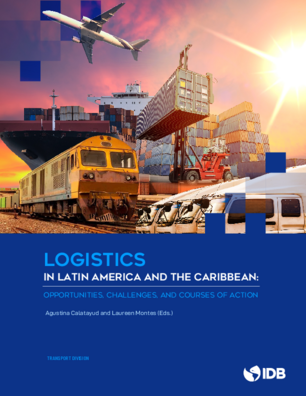Logistics in Latin America and the Caribbean: Opportunities, Challenges and Courses of Action
Date
May 2021
EDITOR
Calatayud, Agustina; Montes, Laureen
Logistics, understood as the set of planning, implementation and control processes that ensure an efficient flow of goods, services and information throughout the supply chain, plays a key role in the economy. Given that inputs, production nodes and consumer markets are distributed in space, logistics allows overcoming the friction of distance and creating spatial convergence between supply and demand (Barbero, 2010). Thus, logistics influences the level of competitiveness and productivity of a country, while providing employment opportunities and access to goods and services for its inhabitants.
In aggregate terms, the logistics performance of Latin America and the Caribbean (LAC) presents a significant lag compared to other regions. International indicators show that LAC systematically rates below the levels of advanced economies, while its own rating has fallen in recent decades. What are the reasons for this setback? What impact does it have on the development goals of the region? How to reverse this trend? These will be the main questions we will address in this post.
To this end, in the first chapter we will explore the relationship between logistics and development goals, and we will quantify the benefits of progress in logistics for LAC countries. Chapters 2 to 5 will analyze the situation of road, rail, sea and air modes in the region. In Chapter 6, we will review the state of trade facilitation, an important complement to international logistics operations. Chapters 7-9 will explore three new challenges in the sector: urban logistics, digital transformation, and decarbonization. In Chapter 10, we will address the geographic dimension of logistics and the importance of multimodality. Finally, in Chapter 11 we will present a roadmap with improvement actions in the short, medium and long term, and in accordance with the state of progress of the sector in the different countries of the region.
In aggregate terms, the logistics performance of Latin America and the Caribbean (LAC) presents a significant lag compared to other regions. International indicators show that LAC systematically rates below the levels of advanced economies, while its own rating has fallen in recent decades. What are the reasons for this setback? What impact does it have on the development goals of the region? How to reverse this trend? These will be the main questions we will address in this post.
To this end, in the first chapter we will explore the relationship between logistics and development goals, and we will quantify the benefits of progress in logistics for LAC countries. Chapters 2 to 5 will analyze the situation of road, rail, sea and air modes in the region. In Chapter 6, we will review the state of trade facilitation, an important complement to international logistics operations. Chapters 7-9 will explore three new challenges in the sector: urban logistics, digital transformation, and decarbonization. In Chapter 10, we will address the geographic dimension of logistics and the importance of multimodality. Finally, in Chapter 11 we will present a roadmap with improvement actions in the short, medium and long term, and in accordance with the state of progress of the sector in the different countries of the region.




